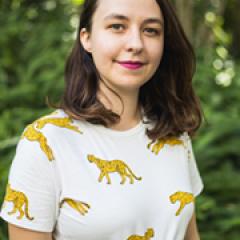I grew up in Zimbabwe, which I always credit with my love of animals and nature in general. It was a beautiful, outdoorsy childhood spent fossicking for chongololos, climbing trees to harass chameleons, having my bare feet punctured by huge acacia thorns and making friendship bracelets for my cat (it was the 90s and did I mention that I was very cool?). From about the age of eight, I wanted to be a wildlife vet, as I had decided that those were the people who got to hug the coolest animals the most frequently.
This career choice persisted through a move to Melbourne during mid-high school (0/10, would not recommend moving continents as an angsty teen) and a failed attempt to get into an undergraduate veterinary science degree. Somewhat reluctantly, I started a Bachelor of Science, telling myself that I’d major in zoology and do vet science afterwards. And then, right towards the end of my undergrad, I realised … I’d actually rather not hug them (and, shockingly, that perhaps that wasn’t all that vets did, anyway). I was taking a few conservation-focused subjects and realised this is what I was passionate about, and what had been driving much of my desire to be a wildlife vet in the first place. I didn’t mind if I wasn’t the one hugging the animals, I just wanted them to still exist to be hugged. (I know, I know, you shouldn’t hug wild animals).
A passion for research
I decided to do a Masters in conservation with one of the lecturers who had inspired me the most – Professor Brendan Wintle. My project was the perfect blend of desktop analysis and fieldwork (aka 98% desktop analysis, 2% fieldwork). We were modelling the impacts of fire on the great desert skink, an Endangered lizard that lives in the deserts of central Australia. We predicted the population trajectory of the skink under nine different scenarios and determined that what was most important for managers was to conduct planned burns to prevent frequent fires in areas we’d identified as prime skink habitat, regardless of some of the uncertainties around habitat preferences. This work got me really excited about the power of spatial analysis for solving conservation problems and I spent the next six years working on similar projects as a full-time research assistant.
In this time, I learnt a lot about doing research, the inner workings of academia, and the role that conservation scientists can play in society. One of the things I noticed over time was how well and how often we collaborated with government, at all levels. Which got me really curious about who we didn’t collaborate with so much: I became interested in the leverage that certain parts of the private sector – particularly, finance – have over society, where, just as governments allocate resources ($$$) to particular issues, like the environment, so too do financial institutions allocate funds ($$$) to particular areas, through who they lend to and invest in.
A move north to Brisbane
This inspired me to (finally) start my PhD, and I moved up to Brisbane in late 2019 (8/10, would recommend leaving Melbourne just before COVID-19, but the coffee here could be better) to join CBCS and work with Professor Martine Maron. My PhD looks at ways to help financial institutions – like banks, superannuation funds and investment companies – incorporate biodiversity into the way they make financial decisions like what areas they invest in, what types of loans they give out, and so on.
I think if you told eight-year-old me what I do on a daily basis (sit in front of a computer, read financial reports and Google what “market cap” means for the 500th time), she’d be bored to tears. But it turns out that eight-year-olds don’t know everything (your cat isn’t going to enjoy wearing that friendship bracelet, dummy) and grown-up me thinks what I’m doing is pretty cool!
Top image: Australian Wildlife Conservancy's Newhaven Wildlife Sanctuary, Northern Territory, the traditional lands of the Ngalia-Warlpiri/Luritja people, and the incredibly beautiful site of my Masters fieldwork. Photo: Natasha Cadenhead
Teaser image: I couldn't find proof of me doing fieldwork, so you'll just have to believe that I go outside sometimes. Photo: Chris Baker

